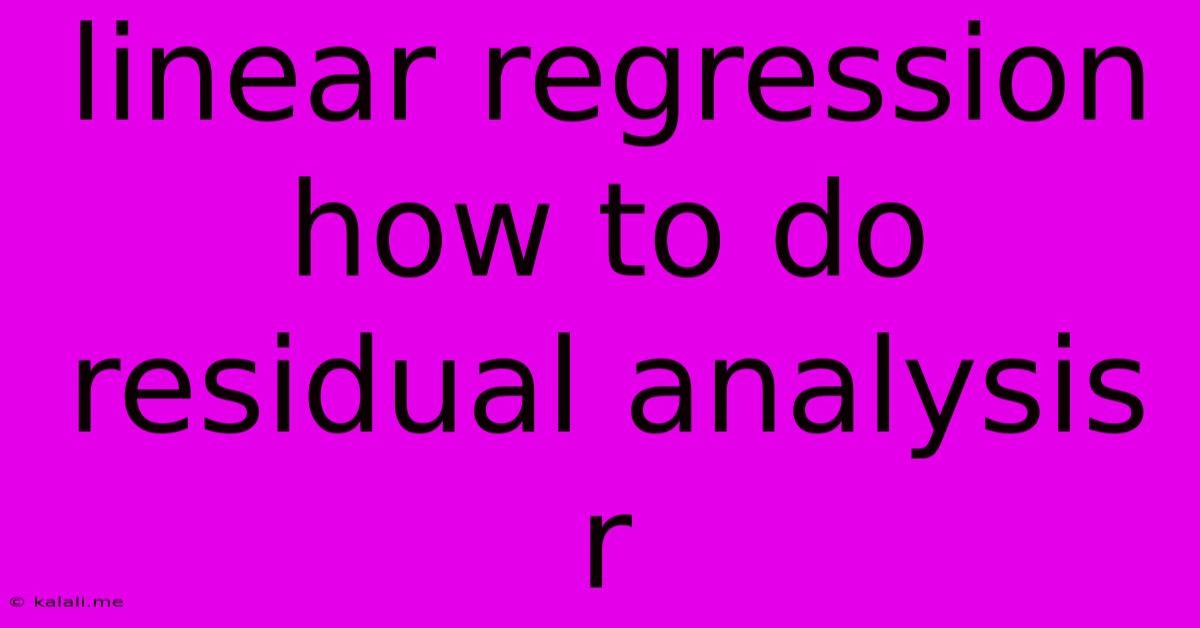Linear Regression How To Do Residual Analysis R
Kalali
Jun 07, 2025 · 4 min read

Table of Contents
Linear Regression: How to Perform Residual Analysis in R
Linear regression is a powerful statistical method used to model the relationship between a dependent variable and one or more independent variables. After fitting a linear regression model, it's crucial to assess its goodness of fit and identify potential issues. Residual analysis is a key tool for this purpose. This article will guide you through performing a comprehensive residual analysis in R, highlighting key diagnostic plots and interpretations. Understanding these techniques is crucial for ensuring your linear regression model is reliable and accurately reflects the data.
What is Residual Analysis?
Residual analysis involves examining the residuals—the differences between the observed values and the values predicted by the model. By analyzing these residuals, we can assess whether the model's assumptions are met and identify potential outliers or influential points that might be skewing the results. The key assumptions of linear regression that residual analysis helps us check include linearity, independence of errors, homoscedasticity (constant variance of errors), and normality of errors.
Performing Residual Analysis in R: A Step-by-Step Guide
Let's assume you've already fitted a linear regression model in R using the lm() function. We'll use a hypothetical example for demonstration:
# Sample data (replace with your own)
data <- data.frame(
X = c(1, 2, 3, 4, 5, 6, 7, 8, 9, 10),
Y = c(2, 4, 5, 4, 6, 7, 9, 10, 11, 13)
)
# Fit the linear regression model
model <- lm(Y ~ X, data = data)
# Summarize the model
summary(model)
Now, let's delve into the residual analysis:
1. Extracting Residuals:
The first step is to extract the residuals from the fitted model:
residuals <- resid(model)
2. Creating Diagnostic Plots:
R offers several built-in functions to create diagnostic plots. The most common and informative are:
- Residual vs. Fitted Plot: This plot examines the relationship between the residuals and the fitted values (predicted values). It helps detect non-linearity, heteroscedasticity (unequal variances of errors), and outliers.
plot(fitted(model), residuals,
xlab = "Fitted Values",
ylab = "Residuals",
main = "Residual vs. Fitted Plot")
abline(h = 0, col = "red") # Add a horizontal line at zero
- Normal Q-Q Plot: This plot assesses the normality assumption of the residuals. If the residuals are normally distributed, the points should fall approximately along a straight diagonal line. Deviations from this line suggest non-normality.
qqnorm(residuals, main = "Normal Q-Q Plot")
qqline(residuals, col = "red")
- Scale-Location Plot (Spread-Location Plot): This plot checks for homoscedasticity. If the spread of residuals is roughly constant across the range of fitted values, the assumption of homoscedasticity is met.
plot(fitted(model), sqrt(abs(residuals)),
xlab = "Fitted Values",
ylab = "Square Root of Absolute Residuals",
main = "Scale-Location Plot")
- Residuals vs. Leverage Plot: This plot helps identify influential points that have a large effect on the regression line. Points with high leverage and large residuals are particularly concerning. This often uses a leverage statistic, usually represented as
hatvalues(model).
plot(hatvalues(model), residuals,
xlab = "Leverage",
ylab = "Residuals",
main = "Residuals vs. Leverage Plot")
3. Interpreting the Plots:
Examine each plot carefully. Look for patterns or deviations from the expected behavior. For instance:
-
Non-linearity: A curved pattern in the residual vs. fitted plot suggests that the relationship between the variables might not be linear. Consider transforming your variables or using a non-linear model.
-
Heteroscedasticity: A fanning-out or fanning-in pattern in the residual vs. fitted plot or the scale-location plot indicates heteroscedasticity. This might require transforming the dependent variable or using weighted least squares regression.
-
Non-normality: Significant deviations from the diagonal line in the normal Q-Q plot suggest that the residuals are not normally distributed. This can affect the reliability of hypothesis tests and confidence intervals. Transformations or robust regression techniques may be necessary.
-
Influential points: Points with high leverage and large residuals in the residuals vs. leverage plot might be outliers or influential points that unduly influence the regression results. Investigate these points carefully to determine whether they are errors or represent genuine data points.
Conclusion:
Residual analysis is an essential part of any linear regression analysis. By carefully examining the diagnostic plots and understanding what they reveal about the model's assumptions, you can build more robust and reliable regression models. Remember to always investigate any deviations from the assumptions and consider appropriate remedial actions. R provides powerful tools to facilitate this process, enabling a thorough and insightful assessment of your linear regression model.
Latest Posts
Latest Posts
-
Can You Do Nikah Without Parents
Jun 07, 2025
-
Does French Press Work On Induction Strove
Jun 07, 2025
-
Be Ye Perfect As I Am Perfect
Jun 07, 2025
-
Should You Have A Range For Desired Salary
Jun 07, 2025
-
Android Disable Long Press On Home Screen
Jun 07, 2025
Related Post
Thank you for visiting our website which covers about Linear Regression How To Do Residual Analysis R . We hope the information provided has been useful to you. Feel free to contact us if you have any questions or need further assistance. See you next time and don't miss to bookmark.